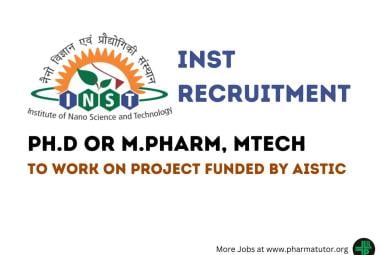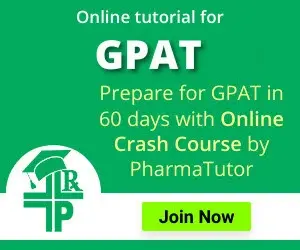Madhya Pradesh Professional Examination Board (MPPEB) also known as MP Vyapam has invited Online Applications are invited for the Recruitment of Drug Inspector from Eligible candidates at the Professional Examination Board of Madhya Pradesh Online Registration website. Board to make recruitment of Drug Inspectors will conduct the Online Test on 8th & 9th April 2017 & now here through going to invite the Online Applications.
Post : Drug Inspector
No. of Vacancies: 18 Posts (UR- 10, SC-02, ST-03, OBC-03)
Qualification :
Degree in Pharmacy or Phrmaceutical Sciences or Medicine with Specialisation in Clinical Phrmacology or Microbiology from a University established in India
Salary: Pay scale 9300-34800 grade pay rs 3600
Application fee:
For Unreserved Candidates: RS 500/-
SC/ ST/ OBC/ PWD (Only MP Residents): RS 250/-
MP Online Portal Fee for submission of Form through KIOSK : RS 70/-
Registered candidate login fee : RS 40/-
Selection procedure : selection of the eligible candidates will be based on through the written examination. Written examination will be objective type and MCQ based. Written test will carry maximum 200 marks for 200 question. Negative marking will not applicable in this examination
Examination Center - Bhopal, Indore, Jabalpur, Gwalior
For More Info Go to Next Page...
Subscribe to Pharmatutor Job Alerts by Email
Syllabus for the recruitment of Drug Inspector
Pharmaceutical Technology Capsules: Advantages and disadvantages of capsule dosage form, material for production of hard gelatin capsules, size of capsules, method of capsule filling, soft gelatin, capsule shell and capsule content, importance of base absorption and minimum/gm factors in soft capsules , quality control, stability testing and storage of capsule dosage forms. Microencapsulation: Types of microcapsules, importance of microencapsulation in pharmacy, microencapsulation by phase separation, coacervation, multi orifice, spray drying, spray congealing, polymerisation complex emulsion, air suspension technique, coating pan and other techniques, evaluation of micro capsules. Tablets: (a)Formulation of different types of tablets, granulation, technology on largescale by various techniques, physics of tablets making, different types of tablet compression machinery and the equipments employed, evaluation of tablets. (b)Coating of Tablets : Types of coating, film forming materials, formulation of coating solution, equipments for coating, coating process, evaluation of coated tablets.(c)Stability kinetics and quality assurance. Parenteral Products: (a)Preformulation factors, routes of administration, water for injection, pyrogenicity, non aqueous vehicles, isotonicity and methods of its adjustment (b)Formulation details, containers and closures and selection. (c)Prefilling treatment, washing of containers and closures, preparation of solution and suspensions, filling and closing of ampoules, vials, infusion fluids, lyophillization & preparation of sterile powders, equipment for large scale manufacture and evaluation of parenteral products.(d)Aseptic Techniques-source of contamination and methods of prevention, Design of aseptic area, Laminar flow bench services and maintenance. (e)Sterility testing of pharmaceuticals. Surgical products : Definition, primary wound dressing, absorbents, surgical cotton, surgical gauzes etc., bandages, adhesive tape, protective cellulosic hemostastics, official dressings, absorbable and nonabsorbable sutures, ligatures and catguts. Medical prosthetics and organ replacement materials. Packaging of Pharmaceutical Products: Packaging components, types, specifications and methods of evaluation, stability aspects of packaging. Packaging equipments, factors influencing choice of containers, legal and other official requirements for containers, package testing. . Liquid Dosages Forms : Introduction, types of additives used in formulations, Vehicles, stabilizers, preservatives, suspending agents, emulsifying agents, solubilizer, colors, flavours and others, manufacturing packaging and evaluation of clear liquids, suspensions and emulsions official in pharmacopoeia. Semisolid Dosage Forms : Definitions, types, mechanisms of drug penetration, factors influencing penetration, semisolid bases and their selection. General formulation of semisolids, clear gels manufacturing procedure, evaluation and packaging.
Pharmaceutical Analysis
Quality assurance: GLP, TQM, Quality Review and Quality Documentation. Validation/Qualification (DQ/IQ/OQ/PQ) , validation of equipment, validation of analytical procedures.
The theoretical aspects, basic instrumentation, elements of interpretation of spectra, and applications of the following analytical techniques should be discussed :
1.Ultraviolet and visible spectrophotometry
2.Fluorimetry.
3.Infrared spectrophotometry.
4.Nuclear Magnetic Resonance spectroscopy including 13c NMR.
5.Mass Spectrometry.
6.Flame Photometry.
7.Chromatography(TLC,HPLC,HPTLC,GLC, Paper Chromatography,)
8.Atomic Absorption Spectroscopy.
Pharmacology and toxicology
Introduction and general principle of pharmacology and toxicology: Mode of action, drug receptor interaction, drug antagonist, absorption, distribution, metabolism and excretion, rate of administration, Bioavailability, drug dependence and addiction, drug abuse and toxicity, drug adverse reaction, Drug allergy of Central nervous system, Cardiovascular system, Autonomic nervous system, Gastro intestinal system and Respiratory system. Pharmacology of Autocoids, Hormones, Hormone antagonists, chemotherapeutic agents including anticancer drugs. Bioassays, Immuno Pharmacology. Drugs acting on the blood & blood forming organs. Drugs acting on the renal system.
Microbiology :
1.Introduction to the scope of microbiology.
2. Classification of microbes and their taxonomy. Actinomycetes, bacteria,
rickettsiae, spirochetes and viruses.
3. Identification of Microbes: Stains and types of staining techniques, electron microscopy.
4. Nutrition, cultivation, isolation of bacteria, actinomycetes, fungi, viruses, etc.
5.Microbial genetics and variation.
6.Control of microbes by physical and chemical methods.
a. Disinfection, factors influencing disinfectants, dynamics of disinfection,
disinfectants and antiseptics and their evaluation.
b. Sterilization, different methods, validation of sterilization methods
& equipments.
7. Sterility testing of all pharmaceutical products.
8. Microbial assays of antibiotics, vitamins & amino acids.
Pharmacognosy
Source, Chemical constituents, uses and adulteration of the following classes of natural drugs, Rauwolfia, Ipecacuanha, Belladona, Cinchona, Cinnamon, Digitalis, Senna, Aloe, Nuxvomica, Opium Alkaloid, Kurchi, Brahmi, Tulsi, Bael and Ephedra. And Glycosides : Chemistry and biosynthesis of digitoxin, digoxin, hecogenin, sennosides, diosgenin and sarasapogenin. Alkaloids: Chemistry, biogenesis and pharmacological activity of atropine and related compounds; quinine, reserpine, morphine, papaverine, ephedrine, ergot and vinca alkaloids.
For More Info Go to Next Page...
Subscribe to Pharmatutor Job Alerts by Email
Hospital & Clinical Pharmacy
Introduction to Clinical Pharmacy. Therapeutic Drug Monitoring Concept of Essential Drugs and Rational Drug use. Drug Store Management and Inventory Control: (a) Organization of drug store, Types of materials stocked, storage conditions (b) Purchase and Inventory Control principles, purchase procedures, Purchase order, Procurement and stocking. Drug distribution Systems in Hospitals:(a) Out-patient dispensing, methods adopted. (b) Dispensing of drugs to in-patients. Types of drug distribution systems. Charging policy, labeling.(c) Dispensing of drugs to ambulatory patients. (d) Dispensing of controlled drugs. Manufacture of Sterile and Nonsterile Products: Policy making of manufacturable items, demand and costing, personnel requirements, manufacturing practice,Master formula Card, production control, Manufacturing records. Records and Reports: Prescription filling, drug profile, patient medication profile,cases on drug interaction and adverse reactions, idiosyncratic cases etc.
Medicinal Chemistry
Structure, nomenclature, classification, synthesis, SAR and metabolism of the following category of drugs, which are official in Indian Pharmacopoeia and British Pharmacopoeia. Introduction to drug design. Stereochemistry of drug molecules. Hypnotics and Sedatives, Analgesics, NSAIDS, Neuroleptics, Antidepressants, Anxiolytics, Anticonvulsants, Antihistaminics, Local Anaesthetics, Cardio Vascular drugs – Antianginal agents Vasodilators, Adrenergic & Cholinergic drugs, Cardiotonic agents, Diuretics, Antijypertensive drugs, Hypoglycemic agents, Antilipedmic agents, Coagulants, Anticoagulants, Antiplatelet agents. Chemotherapeutic agents – Antibiotics, Antibacterials, Sulphadrugs. Antiproliozoal drugs, Antiviral, Antitubercular, Antimalarial, Anticancer, Antiamoebic drugs. Diagnostic agents. Preparation and storage and uses of official Radiopharmaceuticals, Vitamins and Hormones. Eicosonoids and their application.
Anatomy and physiology
Elementary knowledge of following systems :-Blood, Digestive System , respiratory system, Eye, Ear, Reproduction system and Urinary system.
Pharmaceutical Jurisprudence
A briefer view. And elaborate study of the following.
a.Pharmaceutical Ethics
b.Pharmacy Act 1948.
c.Drugs and Cosmetics Act 1940 and Rules 1945.
d.Narcotic Drugs & Psychotropic Substances Act 1985 & Rules.
e.Drugs Price Control Order.
f.Drugs and Magic Remedies (Objectionable Advertisements) Act 1954
g.Prevention of Cruelty to Animals Act 1960.
h. Drugs Patent Act
Biopharmaceutics & Pharmacokinetics
Introduction to Biopharmaceutics and Pharmacokinetics and their role in
formulation development and clinical setting..Biopharmaceutics Passage of drugs across biological barrier (passive diffusion, active transport, facilitated diffusion and pinocytosis). Factors influencing absorptionPhysicochemical, physiological and pharmaceutical. Drug distribution in the body, plasma protein binding. Phamacokinetics Significance of plasma drug concentration measurement.Compartment model-Definition and Scope. Pharmacokinetics of drug absorption -Zero order and first order absorption rate constant using Wagner-Nelson and LooReigel man method. Volume of distribution and distribution coefficient. Compartment kinetics -One compartment and two compartment odels.Determination of pharmacokinetic parameters from plasma and urine data after drug administration by intravascular r and o'al route.Curve fitting (method of Residuals), regression procedures. Clearance concept, Mechanism of renal clearance, clearance ratio, determination of renal clearance.Extraction ratio, hepatic clearance, biliary excretion, Extrahepatic circulation. Non-linear pharmacokinetics with special reference to one compartment model after 1. V drug administration, Michaeles Menten Equation, detection of non-linearity (Saturation mechanism). Clinical Pharmacokinetics Definition and scope . Dosage adjustment in patients with and without renal and hepatic failure. Design of single dose bio-equivalence study and relevant statistics. Pharmacokinetic drug interactions and their significance in combination therapy. Bioavailability and bioequivalence Measures of bioavailability, Cmax, t max, and Area Under the Curve (AUe). Design of single dose bioequivalence study and relevant statistics. Review of regulatory requirements for conduction of Bioequiv alent studies.
Pharmaceutical Biotechnology
Genetic Recombination : Transformation, conjugation, transduction, protoplast fusion and gene cloning and their applications. Development of hybrid om a for monoclonal antibodies. Study of drugs produced by biotechnology such as Activase, Humulin, Humatrope, HB etc. Antibiotics: Historical development of antibiotics. Antimicrobial spectrum and methods used for their standardization. Screening of soil for organisms producing antibiotics, fermenter, its design, control of different parameters. Isolation of mutants, factors influencing rate of mutation. Design of fermentation process. Isolation of fermentation products with special reference to penicillins,streptomycins tetracyclines and vitamin B12
Important Dates:
1. Starting date of Online Application Form filling: 10-03-2017
2. Last Date for filling of Online Application form: 24-03-2017
3. Last date for Correction in Application form: 29-03-2017
4. Date of Online Examination: 8th & 9th April 2017
DOWNLOAD APPLICATION FORM AND MORE INFO
See All M.Sc Alerts Ph.D Alerts Madhya Pradesh Alerts
See All Other Jobs in our Database











.png)

